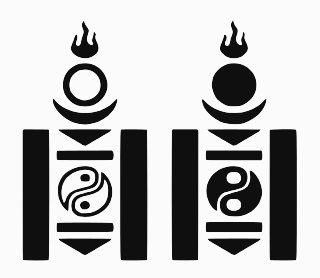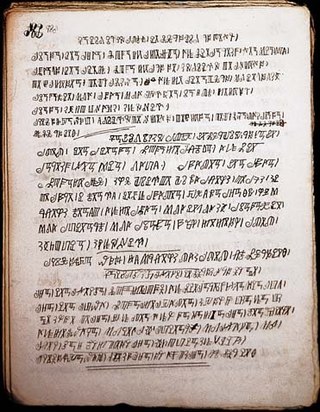Hanunoo script
Last updated| Hanunó'o (Mangyan Baybayin/Surat Mangyan) ᜱᜨᜳᜨᜳᜢ | |
|---|---|
 | |
| Script type | |
Time period | c. 1300–present |
| Direction | Left-to-right, bottom-to-top |
| Languages | Hanunó'o, Tagalog |
| Related scripts | |
Parent systems | Proto-Sinaitic script [a]
|
Sister systems | In the Philippines: Buhid (Mangyan Baybayin, Surat Mangyan) Contents
|
| ISO 15924 | |
| ISO 15924 | Hano(371),Hanunoo (Hanunóo) |
| Unicode | |
Unicode alias | Hanunoo |
| U+1720–U+173F | |
[a] The Semitic origin of the Brahmic scripts is not universally agreed upon. | |
| Brahmic scripts |
|---|
| The Brahmi script and its descendants |
Hanunoo (IPA: [hanunuʔɔ] ), also rendered Hanunó'o, is one of the scripts indigenous to the Philippines and is used by the Mangyan peoples of southern Mindoro to write the Hanunó'o language. [1] [2]
It is an abugida descended from the Brahmic scripts, closely related to Sulat Tagalog, and is famous for being written vertical but written upward, rather than downward as nearly all other scripts (however, it is read horizontally left to right). It is usually written on bamboo by incising characters with a knife. [3] [4] Most known Hanunó'o inscriptions are relatively recent because of the perishable nature of bamboo. It is therefore difficult to trace the history of the script. [2]
Structure
Fifteen basic characters of the Hanunó'o script each represent one of the fifteen consonants /p//t//k//b//d//ɡ//m//n//ŋ//l//r//s//h//j//w/ followed by the inherent vowel /a/. [4] Other syllables are written by modifying each of these characters with one of two diacritics (kudlit) which change the vowel sound to /i/ or /u/. [3] The glyph for /la/ is the same as that for /ra/ but /li/ and /ri/ are distinct, as are /lu/ and /ru/. There are three independent (phonetically preceded by a glottal stop, transliterated as q). [5] Final consonants are not written, and so must be determined from context. [3] Dutch anthropologist Antoon Postma, who went to the Philippines from the Netherlands in the 1950s, introduced the pamudpod virama(᜴ ) to indicate a syllable final consonant. [6] The pamudpod is also used in modern Baybayin.
ᜠ a | ᜡ i | ᜢ u | - - |
ᝒ i | ᝓ u | ᜴ - pamudpod |
ᜣ ka | ᜤ ga | ᜥ nga | ᜦ ta | ᜧ da | ᜨ na | ᜩ pa | ᜪ ba | ᜫ ma | ᜬ ya | ᜭ ra | ᜮ la | ᜯ wa | ᜰ sa | ᜱ ha |
ᜣ + ᝒ ᜣᜲ ki | ᜤ + ᝒ ᜤᜲ gi | ᜥ + ᝒ ᜥᜲ ngi | ᜦ + ᝒ ᜦᜲ ti | ᜧ + ᝒ ᜧ di | ᜨ + ᝒ ᜨᜲ ni | ᜩ + ᝒ ᜩᜲ pi | ᜪ + ᝒ ᜪᜲ bi | ᜫ + ᝒ ᜫᜲ mi | ᜬ + ᝒ ᜬᜲ yi | ᜭ + ᝒ ᜭᜲ ri | ᜮ + ᝒ ᜮᜲ li | ᜯ + ᝒ ᜯᜲ wi | ᜰ + ᝒ ᜰᜲ si | ᜱ + ᝒ ᜱᜲ hi |
ᜣ + ᝓ ᜣᜳ ku | ᜤ + ᝓ ᜤᜳ gu | ᜥ + ᝓ ᜥᜳ ngu | ᜦ + ᝓ ᜦᜳ tu | ᜧ + ᝓ ᜧᜳ du | ᜨ + ᝓ ᜨᜳ nu | ᜩ + ᝓ ᜩᜳ pu | ᜪ + ᝓ ᜪᜳ bu | ᜫ + ᝓ ᜫᜳ mu | ᜬ + ᝓ ᜬᜳ yu | ᜭ + ᝓ ᜭᜳ ru | ᜮ + ᝓ ᜮᜳ lu | ᜯ + ᝓ ᜯᜳ wu | ᜰ + ᝓ ᜰᜳ su | ᜱ + ᝓ ᜱᜳ hu |
ᜣ + ᜴ ᜣ᜴ -k | ᜤ + ᜴ ᜤ᜴ -g | ᜥ + ᜴ ᜥ᜴ -ng | ᜦ + ᜴ ᜦ᜴ -t | ᜧ + ᜴ ᜧ᜴ -d | ᜨ + ᜴ ᜨ᜴ -n | ᜩ + ᜴ ᜩ᜴ -p | ᜪ + ᜴ ᜪ᜴ -b | ᜫ + ᜴ ᜫ᜴ -m | ᜬ + ᜴ ᜬ᜴ -y | ᜭ + ᜴ ᜭ᜴ -r | ᜮ + ᜴ ᜮ᜴ -l | ᜯ + ᜴ ᜯ᜴ -w | ᜰ + ᜴ ᜰ᜴ -s | ᜱ + ᜴ ᜱ᜴ -h |
The script makes use of single ( ᜵ ) and double ( ᜶ ) danda punctuation characters. [6]
Direction of writing

![A bamboo bow (bayi,
[?][?][?]) from Oriental Mindoro, inscribed with Hanuno'o. Bayi, a bamboo bow from Mindoro.jpg](http://upload.wikimedia.org/wikipedia/commons/thumb/d/d6/Bayi%2C_a_bamboo_bow_from_Mindoro.jpg/220px-Bayi%2C_a_bamboo_bow_from_Mindoro.jpg)
The Hanunó'o script is conventionally written away from the body (from bottom to top) in columns which go from left to right. [3] Within the columns, characters may have any orientation but the orientation must be consistent for all characters in a text. The characters are typically vertical with the /i/ diacritic on the left and the /u/ on the right, or horizontal with the /i/ on the top and the /u/ on the bottom. [5] Left-handed people often write in mirror image, which reverses both the direction of writing (right to left instead of left to right) and the characters themselves. [4]
Learning the script
Young Hanunó'o men and women (called layqaw) [8] learn the script primarily in order to memorize love songs. The goal is to learn as many songs as possible, and using the script to write the songs facilitates this process. The script is also used to write letters, notifications, and other documents. The characters are not memorized in any particular order; learners typically begin by learning how to write their name. Literacy among the Hanunó'o people is high despite a lack of formal education in the script. [4]
Examples
The Hanunó'o people's poetry, Ambahan, consists of seven syllable lines inscribed onto bamboo segments, nodes, musical instruments or other materials using the tip of a knife. Charcoal and other black pigments are then used to make the characters stand out. The poems represent a Mangyan's personal thoughts, feelings or desires. It is recited during social occasions (without accompaniment), in courting ceremonies or when requested.
- Hanunoo text
ᜰᜲ ᜠᜩᜳ ᜪ ᜢ ᜩ ᜧ
ᜨᜳ ᜣ ᜦᜲ ᜨ ᜤᜲ ᜧ ᜫ
ᜫ ᜢ ᜮ ᜫ ᜧᜲ ᜣ ᜨ
ᜫ ᜦ ᜣᜲ ᜫ ᜧᜲ ᜣ ᜯ
ᜨᜳ ᜣ ᜦᜲ ᜨ ᜤᜲ ᜧᜳ ᜫ
ᜤ ᜰᜲ ᜬᜳ ᜧᜲ ᜰ ᜠ ᜥ
ᜤ ᜩ ᜦ ᜧ ᜬᜳ ᜧ ᜫ ᜶
- Hanunoo text with pamudpod
ᜰᜲ ᜠᜬ᜴ᜩᜳᜧ᜴ ᜪᜬ᜴ ᜢ ᜥ ᜧᜨ᜴
ᜨᜳ ᜣᜥ᜴ ᜦᜲ ᜨ ᜤᜲᜨ᜴ᜧᜳ ᜫᜨ᜴
ᜫᜬ᜴ ᜦ ᜣᜲᜩ᜴ ᜫ ᜧᜲ ᜣᜬ᜴ ᜯᜨ᜴
ᜫᜳ ᜣᜥ᜴ ᜦᜲ ᜨ ᜤᜲᜨ᜴ ᜧᜳ ᜫᜨ᜴
ᜤ ᜰᜲ ᜬᜳᜨ᜴ ᜧᜲ ᜰ ᜠᜧ᜴ ᜥᜨ᜴
ᜤ ᜩᜤ᜴ ᜦᜥ᜴ᜧ ᜬᜳᜨ᜴ ᜧᜲ ᜫᜨ᜴᜶
- Transliteration
Si ay-pod bay u- pa- dan
No kang ti- na gin-du- man
May u- lang ma- di kag-nan
May ta- kip ma di kay-wan
Mo kang ti- na gin-du- man
Ga si- yon di sa ad- ngan
Ga pag- tang-da- yon di-man.
- English
You my friend, dearest of all,
thinking of you makes me sad;
rivers deep are in between
forests vast keep us apart
But thinking of you with love;
as if you are here nearby
standing, sitting at my side.
Unicode
The Unicode range for Hanunó'o is U+1720–U+173F:
| Hanunoo [1] [2] Official Unicode Consortium code chart (PDF) | ||||||||||||||||
| 0 | 1 | 2 | 3 | 4 | 5 | 6 | 7 | 8 | 9 | A | B | C | D | E | F | |
| U+172x | ᜠ | ᜡ | ᜢ | ᜣ | ᜤ | ᜥ | ᜦ | ᜧ | ᜨ | ᜩ | ᜪ | ᜫ | ᜬ | ᜭ | ᜮ | ᜯ |
| U+173x | ᜰ | ᜱ | ᜲ | ᜳ | ᜴ | ᜵ | ᜶ | |||||||||
| Notes | ||||||||||||||||
See also
- Baybayin
- Buhid script
- Tagbanwa alphabet
- Kawi script
- Filipino orthography
- Kulitan
- See multilingual support for fonts supporting Hanunó'o
Related Research Articles

The Arabic alphabet, or Arabic abjad, is the Arabic script as specifically codified for writing the Arabic language. It is written from right-to-left in a cursive style, and includes 28 letters, of which most have contextual letterforms. The Arabic alphabet is considered an abjad, with only consonants required to be written; due to its optional use of diacritics to notate vowels, it is considered an impure abjad.

The Tengwar script is an artificial script, one of several scripts created by J. R. R. Tolkien, the author of The Lord of the Rings.

The Soyombo script is an abugida developed by the monk and scholar Zanabazar in 1686 to write Mongolian. It can also be used to write Tibetan and Sanskrit.
Baybayin is a Philippine script. The script is an abugida belonging to the family of the Brahmic scripts. Geographically, it was widely used in Luzon and other parts of the Philippines prior to and during the 16th and 17th centuries before being replaced by the Latin alphabet during the period of Spanish colonization. It was used in the Tagalog language and, to a lesser extent, Kapampangan-speaking areas; its use spread to the Ilocanos in the early 17th century. In the 19th and 20th centuries, baybayin survived and evolved into multiple forms—the Tagbanwa script of Palawan, and the Hanuno'o and Buhid scripts of Mindoro—and was used to create the constructed modern Kulitan script of the Kapampangan and the Ibalnan script of the Palawan people. Under the Unicode Standard and ISO 15924, the script is encoded as the Tagalog block.
The Batak script is a writing system used to write the Austronesian Batak languages spoken by several million people on the Indonesian island of Sumatra. The script may be derived from the Kawi and Pallava script, ultimately derived from the Brahmi script of India, or from the hypothetical Proto-Sumatran script influenced by Pallava.

The Tamil script is an abugida script that is used by Tamils and Tamil speakers in India, Sri Lanka, Malaysia, Singapore, Indonesia and elsewhere to write the Tamil language. It is one of the official scripts of the Indian Republic. Certain minority languages such as Saurashtra, Badaga, Irula and Paniya are also written in the Tamil script.
Khmer script is an abugida (alphasyllabary) script used to write the Khmer language, the official language of Cambodia. It is also used to write Pali in the Buddhist liturgy of Cambodia and Thailand.

Surat Buhid is an abugida used to write the Buhid language. As a Brahmic script indigenous to the Philippines, it closely related to Baybayin and Hanunó'o. It is still used today by the Mangyans, found mainly on island of Mindoro, to write their language, Buhid, together with the Filipino latin script.

Tagbanwa is one of the scripts indigenous to the Philippines, used by the Tagbanwa and the Palawan people as their ethnic writing system.

Mangyan is the generic name for the eight Indigenous groups found on the island of Mindoro, southwest of the island of Luzon, each with its own tribal name, language, and customs. The total population may be around 280,001, but official statistics are difficult to determine under the conditions of remote areas, reclusive tribal groups and some having little if any outside world contact.

The Kawi or Old Javanese script is a Brahmic script found primarily in Java and used across much of Maritime Southeast Asia between the 8th century and the 16th century. The script is an abugida, meaning that characters are read with an inherent vowel. Diacritics are used, either to suppress the vowel and represent a pure consonant, or to represent other vowels.

The Cham script is a Brahmic abugida used to write Cham, an Austronesian language spoken by some 245,000 Chams in Vietnam and Cambodia. It is written horizontally left to right, just like other Brahmic abugidas.

The Yi scripts are two scripts used to write the Yi languages; Classical Yi, and the later Yi syllabary. The script is historically known in Chinese as Cuan Wen or Wei Shu and various other names (夷字、倮語、倮倮文、畢摩文), among them "tadpole writing" (蝌蚪文).
Hanunoo may refer to:
Hanunoo, or Hanunó'o, is a language spoken by Mangyans in the island of Mindoro, Philippines.

The Bamum scripts are an evolutionary series of six scripts created for the Bamum language by Ibrahim Njoya, King of Bamum. They are notable for evolving from a pictographic system to a semi-syllabary in the space of fourteen years, from 1896 to 1910. Bamum type was cast in 1918, but the script fell into disuse around 1931. A project began around 2007 to revive the Bamum script.

Kulitan, also known as súlat Kapampángan and pamagkulit, is one of the various indigenous suyat writing systems in the Philippines. It was used for writing Kapampangan, a language mainly spoken in Central Luzon, until it was gradually replaced by the Latin alphabet.
Hanunoo is a Unicode block containing characters used for writing the Hanunó'o language. It also contains the two punctuation marks which are unified characters for all the Philippine scripts.
Ambahan is a traditional form of poetry by the Hanunó'o Mangyan people of Mindoro, Philippines.
Suyat is the modern collective name of the indigenous scripts of various ethnolinguistic groups in the Philippines prior to Spanish colonization in the 16th century up to the independence era in the 21st century. The scripts are highly varied; nonetheless, the term was suggested and used by cultural organizations in the Philippines to denote a unified neutral terminology for Philippine indigenous scripts.
References
- ↑ "Protect all PH writing systems, heritage advocates urge Congress". April 27, 2018.
- 1 2 Postma, Antoon (July 1971). "Contemporary Mangyan Scripts". Philippine Journal of Linguistics. 2 (1): 1–12.
- 1 2 3 4 Rubino, Carl. "The Hanunoo Script". Ancient Scripts of the Philippines. Retrieved October 8, 2016.
- 1 2 3 4 Conklin, Harold C. (2007). Fine Description: Ethnographic and Linguistic Essays. New Haven: Yale University Southeast Asia Studies. pp. 320–342.
- 1 2 Daniels, Peter; William Bright (1996). The World's Writing Systems. New York: Oxford University Press. pp. 481–484.
- 1 2 "Chapter 17: Indonesia and Oceania" (PDF). Unicode Consortium. March 2020.
- ↑ Harold C. Conklin (1953). Hanunóo-English Vocabulary. University of California Press. p. 79.
báyi (1): a hunting bow, usually of bamboo; frequently extended to mean bow and arrows collectively. báyi (2): the bamboo part of a gitgit (violin) bow
- ↑ T.L.S. (Times literary supplement). Oxford University Press. 1966. p. 204.
layqaw refers to a category of 'marriageable but unmarried youth'
External links
Text is available under the CC BY-SA 4.0 license; additional terms may apply.
Images, videos and audio are available under their respective licenses.